Airfix 1/48 Meteor F.8
By 1947, the Meteor fighter had been in production slightly more than four years, with an airframe that was much the same as the original prototype, other than extensions of the engine nacelles which had been accomplished with the F.Mk.4 and resulted in a significant aerodynamic cleanup of the airframe with a concomitant increase in speed. The Meteor F.Mk.8 was the result of a development program on the part of Gloster Aircraft to extend the life of the Meteor line by raising the limiting Mach number. The Meteor was the first demonstration of how far Britain would fall behind in aircraft development during the 1950s, a position from which the British aircraft industry would never recover.
To improve the Meteor's performance, and provide for new equipment made necessary by changing operational requirements, Gloster embarked on a major redesign of the airframe while attempting to keep as many F.4 components as possible. Most prominently, the fuselage of the Meteor 8 was lengthened by 30 inches, moving the ammunition and weapons forward the same distance, and allowing an additional 50 gallon fuel tank to be installed. It was hoped that this would also result in the deletion of the lead ballast carried in the nose of the F.4; Meteor F.4 RA382 had the lengthened nose, but it was discovered that deleting the lead ballast had the unfortunate effect of shifting the center of gravity to the rear as ammunition was expended, with increasing airframe instability.
The solution was discovered almost by accident. Tests were being carried out on the E.1/44 prototype in the Farnborough wind tunnel, where it was discovered that the tail assembly of this airplane would provide the necessary control for the F.8. Once an E.1/44 tail was grafted onto RA382, it handled beautifully without ballast. Other improvements included a new gunsight and the Martin Baker Mk.2 ejection seat.
The first F.8 prototype, VT150, made its first flight on October 12, 1948. A further change was made when it was discovered that the under fuselage ejection slots for spent shell casings was scoring the belly tank and rear fuselage; large external chutes were fitted to the slots to carry the shell casings clear. A pair of Rolls Royce Derwent 8s gave the F.Mk.8 a top speed of 590 m.p.h. Later, the size of the air intakes was increased by 4.5 inches in diameter, which resulted in an extra 200 pounds of thrust for each engine due to the increased air mass available. This resulted in a top speed of around 600 m.p.h.
The first F.8, VZ438, was handed over to the RAF on December 10, 1949, while the last WL191 left the assembly line on April 9, 1954 (by which time the USAF had introduced the F-100 into service and the V-VS the MiG-19). Thirty two RAF squadrons and eleven Auxiliary Air Force squadrons would operate the Meteor between its first appearance on the squadron level in 1950 and its final replacement by the Hunter in 1958. The F.Mk.8 was also operated by the air forces of Australia, Denmark, the Netherlands, Belgium, Israel, Egypt, Syria, and Brazil until as late as the 1970s. The final use of the F.Mk.8 was as a target drone, under the designation Meteor U.16.
By the time the first Mk.8 flew operationally, the second-generation American F 86A Sabre and the Soviet MiG 15 were already operational with the first units of their respective air forces; the first generation F.8 was obsolescent if not completely obsolete from its first day of service. Just how outclassed the Meteor was by these two second generation fighters became apparent over Korea, when only the quality of the pilots would keep 77 Squadron RAAF from experiencing greater losses at the hands of the MiG 15 than they did.
The Meteor in Korea
The RAAF became involved in the Korean War immediately after the UN Security Council Resolution was passed on June 27, 1950. 77 Squadron, which was based at Iwakuni, Japan, as part of the Commonwealth Occupation Force and flying Australian-built P-51D Mustangs, was a standout in providing close air support during the UN retreat down the Korean peninsula to what became known as the Pusan Perimeter. With the successful invasion of Inchon in Seotember 1950, the squadron moved from Japan to Korea, and provided air support to the Marines during the breakout from the Chosin Reservoir following the Chinese intervention in Korea.
The RAAF determined to re-equip 77 Squadron with jet fighters in early 1951. The unanimous recommendation of the pilots in Korea was that the RAAF obtain the American F-86, which was the only UN fighter in Korea that could successfully oppose the MiG-15. Unfortunately, despite the pilots forcefully pointing out that no first-generation jet could successfully go against the MiG-15, as a result of Commonwealth politics, the Australian government decided to obtain the best British fighter, the Gloster Meteor F.8, and 94 Meteors were ordered.
Delivery was made quickly, and 77 Squadron was ordered back to Japan for conversion training in late April 1951. The first T.7 trainers arrived soon after. Thirty F.8s arrived soon thereafter, and the squadron's conversion was completed by the end of May. 77 Squadron then moved to Kimpo Airfield outside Seoul, South Korea, in June for familiaization training.
Operational Meteor flights began on 29 July 1951, with the Meteors assigned as bomber escorts along with the F-84 Thunderjets of the 49th Fighter Wing. MiGs were not encountered until 29 August, when eight Meteors on escort duty in "MiG Alley" were engaged by sixteen MiG 15s. One Meteor was lost in the quick battle; the pilot, Warrant Officer Ron Guthrie, ejected over North Korea and was captured. Another Meteor was badly damaged but the pilot managed to nurse it back to the airfield at Kimpo while a third was less heavily-damaged. Similar encounters followed over the next several months, with the MiGs always coming off best though the Meteors suffered no more losses in combat. The truth was, against a second-generation fighter, the Meteor was a dog. British pilots in the RAF flying Meteors prayed publicly to be re-equipped with Canadair Sabres.
On December 1, 1951, 12 Meteors were intercepted by 40 MiG-15s flown by Soviet pilots of the 324th IAD over Sunchon. While Flying Officer Bruce Gogerly managed to score the first Meteor MiG kill, the Soviet pilots conclusively demonstrated that the day of the Meteor as an air superiority fighter was long past.
As Soviet MiG ace Lt. Colonel Sergey Vishnyakov, who shot down two of the Australian fighters, recalled, “I opened fire and saw my shell bursts dancing all over the enemy aircraft. Its right engine flamed. I noticed the Meteor wingman's tail flying off as result of the burst from my wingman. I saw another Meteor leaving the battle. We overtook him and attacked. I managed to frame him in my sights and opened fire. My shells burst on the Meteor's wings and the pilot baled out.”
While two MiGs were claimed, four Meteors had been blown out of the sky by fighters that could fly rings around them. It was quickly decided that the Meteors would not be sent into North Korea again in the air superiority role. After a morale sapping period of airfield defense where the pilots sat runway alerts and saw no fighting, 77 Squadron was once more employed in a ground attack role utilizing the Meteor's good low-level performance and sturdy construction beginning in early 1952. This remained the mainstay of the squadron's operations until war ended in June 1953. The Squadron still occasionally encountered MiGs in this role and one more MiG was shot down in March 1953 by Flight Sergeant John Hale, bringing the final score to five Meteors shot down against three MiGs. By the end of the war 77 Squadron had flown 18,872 sorties, mostly in Meteors, with 37 pilots killed and seven taken prisoner. Thirty Meteors were lost during the war, 25 to enemy ground fire.
The kit
Airfix announced the release of a 1/48 meteor F.8 last year. Modelers who had struggled with the Classic Airframes kits were very happy with this news. The kit was released this past April in the UK, finally arriving on this side of the Atlantic in May. Sales have been brisk, to say the least.
The positive response to the kit is justified on opening the big red box. The kit is logically laid out, with crisp molding and surface detail that looks good under the proverbial “coat of paint.”
Both the early “small bore” intakes and later “large bore” intakes are provided, and the kit also includes two Derwent engines which can be displayed with the engine covers off. The early framed canopy and later blown canopy are also present. The framed canopy has the bulged canopy that has eluded the makers of previous meteor F.8 kits. Decals are provided for two RAF Meteors, one in “high speed silver” and one in camouflage.
Compared to the truly wretched Classic Airframes “putty monsters,” the Airfix Meteor is nearly trouble-free. It's not totally trouble-free, but the problems that exist are easily solved and certainly nowhere near the difficulty and problems of the earlier kits.
All of the kits so far have a warp in the right half of the fuselage, in the upper rear area of the fuselage. Since the plastic is soft enough, it is easy to press down on the area and bend it into the proper position.
Modelers have noted problems with the fuselage-wing fairing pieces, with some modelers finding that there is a substantial gap between the fuselage and upper wing when the two sub-assemblies are joined. This is a modeler-induced problem. The solution is to very carefully attach the fairing piece to the fuselage, and get it absolutely perfectly aligned with the surrounding fuselage half, then let it set up solidly before attempting to attach the wing. Everything will fit correctly.
Fixing the fuselage warp and careful assembly of the wing fairings allowed me to assemble the kit with filler only being necessary to hide the seam on the upper fuselage centerline. It only took me some three hours to assemble the complete airframe to that point. I added as many fishweights as I could squeeze into the area behind the cockpit between the cannon bays to insure nose-sitting. I also used the kit ejection seat, with the part that had the molded-in seatbelts. A resin seat would look good here, but given that everything including the seat is flat black, the kit part is just fine.
The nose cone is the one “big problem” in the kit. With the nose wheel assembly in place with the forward wheel well door attached, the cone does not want to fit. I found that I needed to take off the forward door. I also needed to thin down the area of the nose cone that attaches to the fuselage. I was then able to push it into position and hold it with rubber bands stretched back to the tail while the cone set up. I then trimmed down the attachment point for the forward wheel well door and cut off about 1/16 of the door at the top end, which allowed me to insert it into the proper position.
I gave the model an overall coat of Tamiya Gloss Black X-1 for a primer, then airbrushed Vallejo “White Aluminum” overall. When that was dry, I gave the model a thin coat of Future.
I used the kit decals for the national insignia, which is the right colors, and for the extensive stencils. I used Xtradecals 48-158 for the individual aircraft markings and did the 77 Squadron F.8 flown by Flt. Sgt. Phillip Zupp in 1952.
When the decals were set, I washed the model to get rid of any dried decal solvent, then gave the model a coat of Clear Satin, so that the final appearance was of slightly-worn aluminum paint.
I attached the landing gear and positioned the canopy in the open position.
This kit is light years better than the old Classic Airframes kits, which can safely be turned into the door stops they have always aspired to be. The kit is easy to assemble if you take care with the details mentioned above, and the result is a really outstanding model, however you finish and mark it. There are lots of decal sheets out there for the F.8 and the two new sheets from Hannant's have a nice international selection of markings possibilities. I am sure this won't be the only one of this kit in my collection.
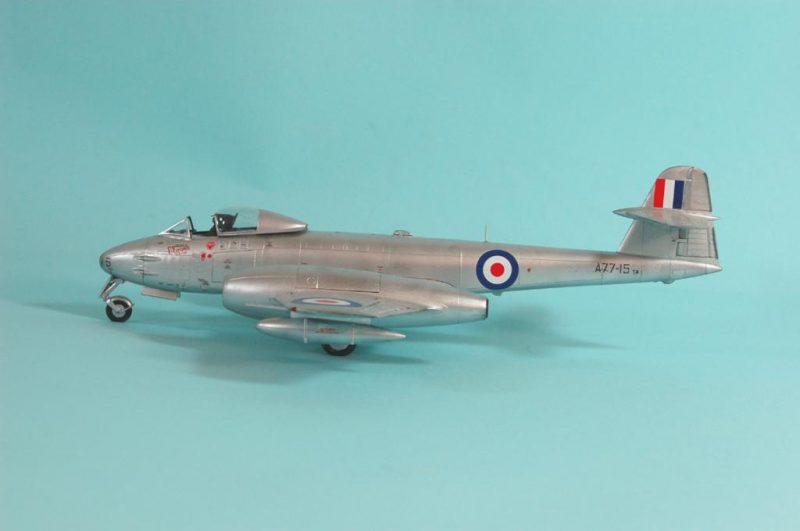
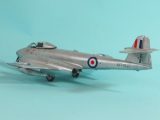
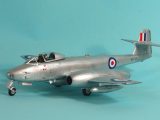
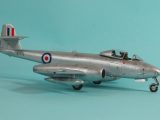
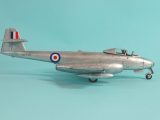

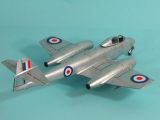
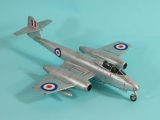
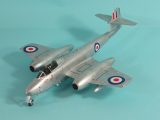
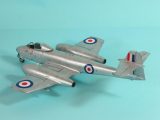
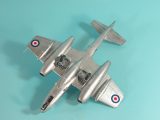
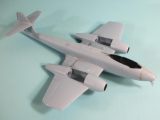
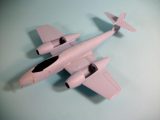
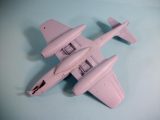
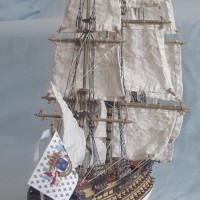
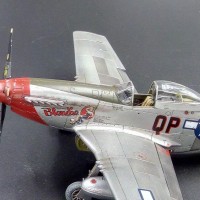
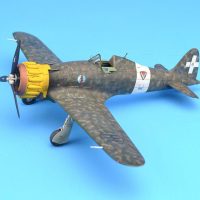
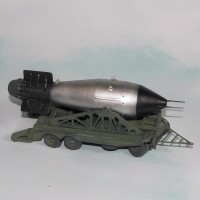
Like nice build!
You did an awesome job with this one. I never liked the Meteor. The Vampire looked more like a fighter. Lovely NMF!
The Vampire? Looked like a fighter? It always looked like a rich man's toy to me.
A toy plane used by Richy Rich.
Looks good Tom…….the nmf came out well as did the photos.
That's beautiful. Love the finish.
For such a relatively easy build that you say it is, it still sounds like it is plagued with problems. But considering CA is out of business, it is all we have. So comparison is meaningless.
Shame no pictures of the issue points to help us see them.
http://modelingmadness.com/review/korean/cleavermet8.htm
http://modelingmadness.com/review/korean/cleavermett7.htm
http://modelingmadness.com/review/korean/cleavermet4.htm
Modeling Madness in their review section has several articles written by TC about CA Meteors with several in progress build photos for comparisons.
Well done as usual!
Lovely build and article on another British classic.
Great build Tom. Love Valleho paints too. Your Hi-speed silver finish looks good as well. Thanks for the background notes; always interesting reading.
Hey Tom, an Aussie bird! Bewdy mate!
Hi Tom,
Thanks so much for making this model of A77-15. As you are no doubt aware, this was a significant aircraft to my father during his time in Korea with 77 Squadron RAAF. He would undoubtedly be impressed by your work and humbled by your mention of him. Thank you so much.
Cheers,
Owen Zupp
This is also the airplane Bruce Gogerly flew for the first meteor MiG kill.